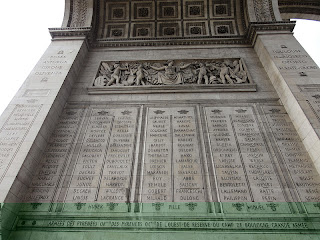
Monday, January 23, 2012
Arc de Triomphe
The Arc de Triomphe (Arc de Triomphe de l'Étoile) is one of the most famous monuments in Paris. It stands in the centre of the Place Charles de Gaulle (originally named Place de l'Étoile), at the western end of the Champs-Élysées. There is a smaller arch, the Arc de Triomphe du Carrousel, which stands west of the Louvre. The Arc de Triomphe (in English: "Triumphal Arch") honours those who fought and died for France in the French Revolutionary and the Napoleonic Wars, with the names of all French victories and generals inscribed on its inner and outer surfaces. Beneath its vault lies the Tomb of the Unknown Soldier from World War I.
The monument stands 50 metres (164 ft) in height, 45 m (148 ft) wide and 22 m (72 ft) deep. The large vault is 29.19 m (95.8 ft) high and 14.62 m (48.0 ft) wide. The small vault is 18.68 m (61.3 ft) high and 8.44 m (27.7 ft) wide. It was the largest triumphal arch in existence until the construction of the Arch of Triumph in Pyongyang, in 1982. Its design was inspired by the Roman Arch of Titus. The Arc de Triomphe is so colossal that three weeks after the Paris victory parade in 1919, (marking the end of hostilities in World War I), Charles Godefroy flew his Nieuport biplane through it, with the event captured on newsreel.
Beneath the Arc is the Tomb of the Unknown Soldier from World War I. Interred here on Armistice Day 1920, it has the first eternal flame lit in Western and Eastern Europe since the Vestal Virgins' fire was extinguished in the fourth century. It burns in memory of the dead who were never identified (now in both world wars). According to a 2008 television programme, presented by Griff Rhys Jones, “the flame has only been extinguished once, by a drunken Mexican football supporter on the night that France beat Brazil here in Paris,” most likely referring to the 1998 FIFA World Cup Final.
A ceremony is held Tomb of the Unknown Soldier every 11 November on the anniversary of the armistice signed between France and Germany in 1918. It was originally decided on 12 November 1919 to bury the unknown soldier's remains in the Panthéon, but a public letter-writing campaign led to the decision to bury him beneath the Arc de Triomphe. The coffin was put in the chapel on the first floor of the Arc on 10 November 1920, and put in its final resting place on 28 January 1921. The slab on top carries the inscription ICI REPOSE UN SOLDAT FRANÇAIS MORT POUR LA PATRIE 1914–1918 ("Here lies a French soldier who died for the fatherland 1914–1918").
In 1961, President John F. Kennedy and First Lady Jacqueline Kennedy of the United States paid their respects at the Tomb of the Unknown Soldier, accompanied by French President Charles de Gaulle. After the 1963 assassination of President Kennedy, Mrs Kennedy remembered the eternal flame at the Arc de Triomphe and requested that an eternal flame be placed next to her husband's grave at Arlington National Cemetery in Virginia. President Charles de Gaulle went to Washington to attend the state funeral, and witnessed Jacqueline Kennedy lighting the eternal flame that had been inspired by her visit to France.
Subscribe to:
Post Comments (Atom)





















No comments:
Post a Comment